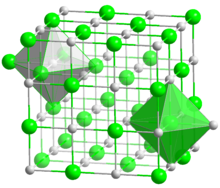
Back Bariumsulfied AF كبريتيد الباريوم Arabic سولفید باریوم AZB Sulfur de bari Catalan Sulfid barnatý Czech Bariumsulfid German Sulfuro de bario Spanish سولفید باریم FA Bariumsulfidi Finnish Sulfure de baryum French
 | |
| Identifiers | |
|---|---|
3D model (JSmol)
|
|
| ChEBI | |
| ChemSpider | |
| ECHA InfoCard | 100.040.180 |
| EC Number |
|
| 13627 | |
PubChem CID
|
|
| UNII | |
CompTox Dashboard (EPA)
|
|
| |
| |
| Properties | |
| BaS | |
| Molar mass | 169.39 g/mol |
| Appearance | white solid |
| Density | 4.25 g/cm3 [1] |
| Melting point | 2,235[2] °C (4,055 °F; 2,508 K) |
| Boiling point | decomposes |
| 2.88 g/100 mL (0 °C) 7.68 g/100 mL (20 °C) 60.3 g/100 mL (100 °C) (reacts) | |
| Solubility | insoluble in alcohol |
Refractive index (nD)
|
2.155 |
| Structure | |
| Halite (cubic), cF8 | |
| Fm3m, No. 225 | |
| Octahedral (Ba2+); octahedral (S2−) | |
| Hazards | |
| GHS labelling: | |
 
| |
| Warning | |
| H315, H319, H335, H400 | |
| P261, P264, P271, P273, P280, P302+P352, P304+P340, P305+P351+P338, P312, P321, P332+P313, P337+P313, P362, P391, P403+P233, P405, P501 | |
| NFPA 704 (fire diamond) | |
| Lethal dose or concentration (LD, LC): | |
LD50 (median dose)
|
226 mg/kg humans |
| Related compounds | |
Other anions
|
Barium oxide Barium selenide Barium telluride Barium polonide |
Other cations
|
Beryllium sulfide Magnesium sulfide Calcium sulfide Strontium sulfide Radium sulfide |
Except where otherwise noted, data are given for materials in their standard state (at 25 °C [77 °F], 100 kPa).
| |
Barium sulfide is the inorganic compound with the formula BaS. BaS is the barium compound produced on the largest scale.[3] It is an important precursor to other barium compounds including BaCO3 and the pigment lithopone, ZnS/BaSO4.[4] Like other chalcogenides of the alkaline earth metals, BaS is a short wavelength emitter for electronic displays.[5] It is colorless, although like many sulfides, it is commonly obtained in impure colored forms.
- ^ Lide, David R., ed. (2006). CRC Handbook of Chemistry and Physics (87th ed.). Boca Raton, Florida: CRC Press. ISBN 0-8493-0487-3.
- ^ Stinn, C., Nose, K., Okabe, T. et al. Metall and Materi Trans B (2017) 48: 2922. https://doi.org/10.1007/s11663-017-1107-5 Archived 2024-01-01 at the Wayback Machine
- ^ Greenwood, Norman N.; Earnshaw, Alan (1997). Chemistry of the Elements (2nd ed.). Butterworth-Heinemann. ISBN 978-0-08-037941-8.
- ^ Holleman, A. F.; Wiberg, E. "Inorganic Chemistry" Academic Press: San Diego, 2001. ISBN 0-12-352651-5.
- ^ Vij, D. R.; Singh, N. (1992). Optical and electrical properties of II-VI wide gap semiconducting barium sulfide. Conf. Phys. Technol. Semicond. Devices Integr. Circuits, 1992. Proceedings of SPIE. Vol. 1523. pp. 608–612. Bibcode:1992SPIE.1523..608V. doi:10.1117/12.634082.
